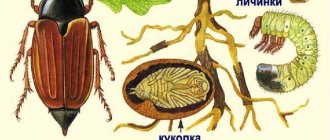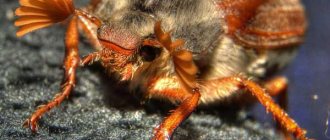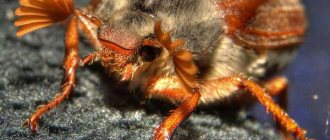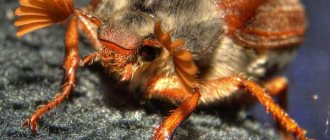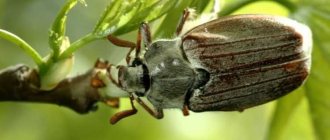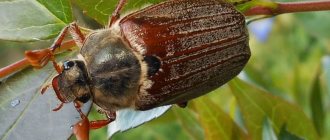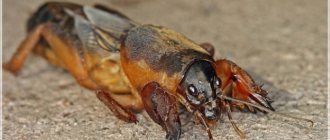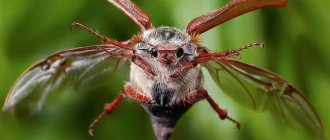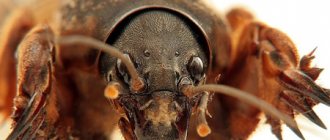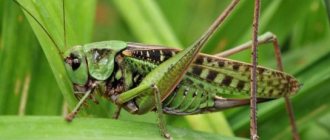Everyone has seen the cockchafer or the cockchafer, or at least heard of it, that’s for sure. With the onset of spring, these large insects on quiet warm evenings, with their wings spread, circle with a roar above the tops of flowering trees. Remember how it was in Taras Grigorievich: “The Khrushchevs are buzzing over the cherries...”.
Unfortunately, these robbers “buzz” only when they go in search of succulent flower buds, greedily eating the insides of flowers and young leaves, thus causing irreparable damage to fruit trees, shrubs and other cultivated plants.
In the middle of the last century, when pesticides began to be actively used to combat colonies of harmful insects in agriculture, the population of cockchafers sharply decreased. But after 1980, due to the ban on the use of outdated chemicals, the growth in the number of beetles quickly increased, and soon their numbers again reached a critical level.
But the May beetle itself or Khrushchev ( lat. Melolonthinae
) – this is only half the story. The trouble is its ugly, voracious larva, which in Ukraine is called a hrobak.
What harm does the cockchafer cause?
The victims of adult beetles are mostly fruit trees and shrubs, where they actively eat young leaves. They are not attracted to grasses and low-growing herbaceous plants. In the years of mass summer of cockchafers (they happen once every 3-5 years), during a short period of their activity they are able to gnaw all the leaves of garden plants over a large area. In other years, their years may pass almost unnoticed.
And the larvae growing in the soil actively spoil the roots of garden and vegetable crops (including root crops) throughout the growing season. Because of them, lawn grass withers, and strawberries often suffer.
The gluttony of these soil caterpillars is such that at 2 years of age it can gnaw off the roots of a pine seedling of the second year of life in a week, and the next year it can cope with it in one day
Beetle body parts
The external structure of the cockchafer is identical to that of other beetles. In addition to the main parts of the body, it has a pronotum, which, together with the head, is covered with hairs of medium length; relative to the rest of the hair, they form stripes along the body. The underwing area is also covered with small hairs. The very part of the body to which the legs are attached and the head have small scales similar to hair. All limbs are divided into individual members, hence the name - Arthropods. The chest has 3 segments, and the abdomen has eight.
Stages of development of Khrushchev
The cockchafer is a fairly large insect. Its body reaches up to 35 mm and is colored black or red-brown. In nature, they inhabit forest-steppes and forests, mainly light coniferous (pine).
In the spring (usually in May) the beetles begin breeding. After mating, the females burrow into the soil and lay eggs. One female May beetle lays up to 70 eggs and then dies. After 1-1.5 months, large, white, quite mobile larvae hatch from the eggs. They are easy to distinguish from other pests, as they seem to be curled into a ball.
Khrushchev larvae live in the soil for 3 to 4 years, and then turn into motionless pupae, which are similar in appearance to adult beetles. The final stage of development of the cockchafer is the imago, when the pupae turn into beetles. This process occurs in late summer or autumn. Young beetles emerging from pupae overwinter in the soil and emerge to the surface in the spring.
Under favorable weather conditions in nature, the population of cockchafers increases, accompanied by a massive flight. The peak number of May beetles is observed 20-25 years after a 3-4 year break in their activity. Right now (that is, these years) there is a peak in the reproduction of these pests. It is believed that this activity can last about 10 years, so it is important to know how to control this pest to reduce the damage it causes.
Internal structure
The internal organs of the cockchafer are well developed. Thanks to this, it adapts perfectly to various environmental conditions, including wintering in the soil.
Digestive system
An adult beetle bites off pieces of leaves with its powerful upper jaw, and crushes them with its lower jaw. Then the crushed food enters the esophagus, and from there into the stomach. Food processed to a pulp state enters the intestines, where it is absorbed.
Respiratory system
The insect breathes through the trachea - a network of branched tubes. Oxygen enters them through small holes - spiracles, which are located at the edges of the dorsal part of the abdomen.
Circulatory system
Khrushchev have an open circulatory system. Blood fills all tissues of insects with oxygen and nutrients, and carries waste products to the excretory organs.
The movement of blood is provided by the heart, which looks like a longitudinal tube.
Nervous system
The nervous system of an arthropod consists of the ventral nerve cord and the peripharyngeal ring. Nerve cells form the brain.
Excretory system
The excretory system of the cockchafer is represented by the so-called Malpighian vessels. These are thin tubes located inside the body.
The products of metabolic reactions are filtered on the surface of these tubes, then turn into crystals and are excreted through the intestines along with undigested food.
Sex organs and reproduction
Females have two ovaries, which pass into the oviducts. The bases of the ovaries merge and form a single oviduct through which the eggs emerge.
The sperm of the male enters a special organ of the female - the spermatic receptacle. They fertilize mature eggs.
The male's reproductive organs are two testes. They pass into the vas deferens, and then into the ejaculatory duct, through which sperm is released.
Sense organs
Well-developed sense organs help the beetle to navigate its environment: smell, vision and touch.
Antennae serve as organs of smell for beetles. They, like antennas of sorts, help insects smell food, for which they can fly up to 1 km.
For touch, they use small palps located on their oral appendages. Beetles use them to feel for food.
May beetle eye
The location and structure of the eyes allows the cockchafer to get a general idea of what is happening around. He distinguishes colors and notices any movement of objects in the immediate vicinity.
What does the cockchafer eat?
Khrushchev, like most insect pests, poses a double threat, since damage is caused not only by adult beetles, but also by their larvae.
If beetles eat leaves mainly within 1-2 months during the flight and reproduction period, then the larvae are more voracious and dangerous. Adult beetles eat the leaves and flowers of fruit trees and shrubs: cherry, plum, sea buckthorn, black currant and apple trees are some of the most favorite trees for cockchafers. But they also love to eat leaves of ornamental trees: aspen, maple, birch, etc.
But this is what the larvae of the cockchafer eat... They gnaw the roots of strawberries, various vegetable crops, fruit trees and shrubs. They like potato tubers and corn roots. They also like to eat the roots of pine, cedar, birch, larch, and spruce. They do not disdain the roots of lawn grass. Older larvae are more voracious than their younger relatives. There is information that one three-year-old larva can eat the roots of a 2-year-old pine tree in one day. But for a 2-year-old larva, the roots of the same tree will last for a whole week. This doesn’t make it much easier for us.
Description of the pest
An adult beetle reaches a length of up to 19 mm. The color of the shell and head are dark brown, and the legs, antennae and edging of the chest shield are yellowish-red. The elytra are lighter, their color is closer to yellow. They shine, and along them there are 4 stripes.
The entire chest of the beetle is covered with long, light-colored hairs; the abdomen also has hairs, but they are shorter. The antennae consist of 9 segments.
The female can be distinguished by shorter and sparse hairs on the body.
The eggs laid by the female June beetle are white, almost round, slightly elongated. For laying, females prefer to choose abandoned or virgin areas overgrown with wild cereals.
The head of the larvae is red, shiny, without eyes. The body is white, curved, and has 3 pairs of legs. The length of the larva can reach 52 mm.
The pupa is light in color, but begins to darken before the adult emerges.
Reproduction of the lamellar family
From the end of May, beetles begin to actively reproduce. After the “weddings,” the female lays the first 20–30 eggs in the roots of the plants. Buries them and returns to continue mating. During the season, one female brings offspring 3–4 times, and in total the number of eggs reaches 40–60, or even 70 pieces. After this, the mother dies, and the children do not need her further presence.
- After a month or a month and a half, the eggs are opened, and larvae emerge from them - large, plump, with a large mouth. For the next three years, in this state, the insect will actively develop, going 1.5 m deeper in the winter, and returning to the upper layers of the soil in the spring.
- In the 3rd year (in southern latitudes) or 4th (for regions with a harsh climate), the larva enters the pupal stage in mid-summer, and this period lasts for about a month and a half.
- Then the pupa turns into an adult beetle, and continues to remain dormant until spring.
- In April - May, when a tunnel is broken, males come to the surface, then females catch up with them. And the cycle begins again: mating, feeding, laying eggs, death of the female, and then the male, development of the larva.
Studying the goal
The breeding season of the cockchafer begins in May, and after mating, the female chafers burrow into the ground and lay eggs.
Life cycle of the cockchafer
No later than a month and a half later, large white larvae appear, which are easily recognized by their curled position. They live for 3-4 years and before the onset of the last winter period in the development cycle, they turn into pupae, from which an adult insect emerges at the end of next summer. Well, thanks to its impressive size, peaceful but annoying disposition, characteristic brown-brown color and insatiable appetite, it is almost impossible to confuse it with another species.
Male and female cockchafer
The larvae of the cockchafer love strawberry roots, as well as the root systems of a number of vegetable crops - corn, potatoes, cabbage, etc. No less attractive to them are the roots of trees, especially fruit trees - cherries, apples and plums, as well as various shrubs, for example, gooseberries and currants.
The cockchafer does not lay eggs in turf, rocky or heavy soils. The age of the larvae can be determined by their size and behavior. Thus, in the first year of life, the width of their head capsule is about 2.5 mm, and they themselves feed mainly on humus and small roots of various vegetation. In the second year, the larva’s head grows approximately twice as large – up to 4 mm, and in the third year – another one and a half times (6-6.5 mm). In August and early September, the caterpillars hide from the cold to a depth of 1-1.5 m, and in the spring they rise again almost to the very surface of the soil - closer to the food. Three-year-old larvae are the most voracious - each of them alone is capable of destroying the root system of a young pine or spruce in a day.
Movement of May larvae in the soil during development
Infestations of the cockchafer, which occur once every 7-10 years, are a real disaster for everyone who has their own garden. If your site is located not far from a forest or oak grove, as well as next to areas already favored by it, sooner or later this insect will come to you.
Lifespan
The development of the cockchafer is long, but its full existence is short. The total life cycle reaches 5 years, of which only one is summer (about 2 months), the beetles are active.
Let's take a closer look at the life stages of a beetle:
- 30 - 40 days - egg stage;
- 3 − 4 years - larval stage;
- 1.5 − 2 months. - pupal stage;
- imago (full-fledged beetle) - about a year, of which the insect is awake for only 5 - 7 weeks.
During this entire cycle, the family living in the roots of the plant can completely destroy the adult tree. Therefore, people actively use chemicals to combat Khrushchev.
Fighting the cockchafer using traditional methods
During the period of the highest activity of the insect, that is, with the appearance of adult individuals, they can be caught by shaking them from trees and bushes. It is best to do this early in the morning, when the cockchafer is in a torpor due to the overnight drop in ambient temperature. Searching for the May beetle for collection and destruction You can also reduce the number of the beetle and its larvae using homemade traps: A shallow container (plastic or metal basin) is dug into the ground in an open area near areas with vegetation or trees and smeared from the inside with grease or special glue for insects
At night, a light source of medium power is installed at the bottom of the basin prepared in this way. In the morning, you will have to dispose of an entire army of insects with your own hands, including many individuals of the cockchafer, which ran up and flew into the light and successfully stuck to the walls of the trap. The neck is cut off from a regular plastic bottle, and 4 holes are made in the walls around the circumference. A cord is threaded through them, by which the trap is suspended among the branches of fruit trees. Then pour a little bread kvass or fermented jam into the bottom. Traps should be checked regularly, adding bait liquids and removing dead insects. Soap trap for beetles Under the lamp, fixed among the branches of garden trees, there is a small container of water, into which a little kerosene should be added.
Trap for the cockchafer The destruction of the cockchafer can be entrusted to poultry. Of course, you shouldn’t let it out into the garden, otherwise the vegetation will be destroyed along with the pests. However, there is no quicker way to get rid of hand-collected larvae and dead adult beetles than by pouring them into a chicken feeder. If walnuts grow on your site, you can safely include a decoction of its leaves in your arsenal of means to combat beetleworm and its larvae.
Western May beetle Melolontha melolontha L.
How to get rid of bark beetle in a wooden house - folk remedies
The Western May beetle is a fairly large beetle, 23-31 mm long, with a powerful, strongly convex body. The main color is black, the elytra, legs and antennae, palps and pygidium are light brown to black-brown. Characterized by strong color variability. The rather small head is elongated into a powerful shield of the pronotum, which is covered especially on the sides with thick light hairs. On the head there is a pair of fan-shaped antennae, which in the male are completed with 7 leaf-shaped plates, wider and 2 times larger than in the female, which has only 6 of them. The brown elytra have 4 ribs. White triangular spots are clearly visible on the sides of the abdomen. The last segment of the abdomen is elongated into a chisel-shaped protrusion - the pygidium, which in the male is longer, more blunt and slightly backward; in the female it is shorter, more pointed and more adjacent to the body, almost vertical. The tibia of the female's front leg is widened and has jagged edges. Western May Khrushchev is distributed throughout most of Europe, in the east it is found in the European part of the former USSR, the distribution border leads from Latvia to Kharkov, then to Zaporozhye and Odessa. The areas of greatest damage, however, are in central Europe.
a — damage to adult beetles on a young oak branch; b - damage to larvae on the roots of a young oak tree; c — end of the abdomen of the May beetle larva; d - Khrushchev egg; e - first, second and third instars of larvae. Khrushchev eggs are oval, approximately 3 x 2 mm in size, dirty white. The larvae are fleshy, whitish-yellow, and shaped like the letter “C”. The head is brown with four-part antennae and strong jaws. Has 3 pairs of thoracic legs. The abdomen consists of 10 segments, the last two of which are massive. The last segment has two parallel longitudinal rows containing 22-30 setae. The larvae have only three instars, which differ in the width of the head chambers (first instar = 2.5 mm, second instar = 4 mm, third instar = 6 mm). The pupa is free, yellowish.
Western May Khrushchev (photo: V.L. Potapova)
Young chafer beetles are found in the soil already at the end of summer and overwinter there until next spring. In the southern regions they usually appear in the second half of April until the beginning of June. In the northern regions, Khrushchev appears from mid-May to the end of June. They fly along the edges of deciduous plantations and mate during additional feeding. Fertilized females with mature eggs stop feeding and always fly along the same paths to open areas for laying eggs. They prefer light, warm soils with sparse soil cover. At a depth of 10-40 mm, 10-30 eggs are laid and return to feed again. This is repeated approximately 3 times. Adults feed along the edges of forest plantations, up to about 50 m deep into the forest; they eat leaves of oak, beech, maple, elm, hazel, poplar, willow, walnut, as well as leaves of fruit trees. The larvae emerge after 40-50 days, at the end of June - July. First they feed on humus particles, then they also eat roots. In northern and central Europe, a 4-year development period predominates; in the warmer southern regions, a 3-year development period prevails. The most significant damage is caused by damage to the roots and thicker roots by second and third instar larvae from May to September. Young spruce and pine trees are most sensitive to damage, and die when the damage is more severe.
Chemical methods of pest control
The use of heavy insecticides should be avoided. Together with the pest, they will also destroy beneficial insects, for example, bees, without which the reproduction of flowering plants is almost impossible, and will also scare off its natural enemies - birds, amphibians and predatory insects. You can protect the area from the invasion of the cockchafer in the following ways: mulching the soil with crushed tree bark, chopped straw or wood shavings and sawdust, which makes it difficult for the insect to penetrate the soil to lay eggs; Mulching the soil with straw aromatically repels the pest - it does not tolerate the smells of elderberry, lupine, representatives of the cruciferous family, turnips, mustard, wormwood, turnips, etc.
"Bazudin"
Made in Switzerland. The active ingredient is diazinon, which requires careful use and compliance with safety measures.
In addition to beetle larvae, Bazudin is also effective against wireworms and some other harmful insects. It has Russian analogues, these are “Grom”, “Kapkan” and “Dohloks”.
Carefully! “Bazudin” is a dangerous substance for fish and other inhabitants of water bodies, so it should not be allowed to get into ponds and rivers!
"Zemlin" and "Pochin"
They also work against several groups of insects that cause damage to crops. To get rid of the “May” offspring, sawdust or dry sand is poured into a 0.5 liter jar, after which you need to add one package of the product and mix the contents well. Used when transplanting seedlings to protect them. Add 1 tsp to each planting hole. the resulting composition.
"Aktofit"
It is an insectoacaricide with contact effects on the digestive system. It works due to natural inhibitory toxins with a specific focus. Once in the insect’s body, it affects its nervous system and causes death.
"Antikhrushch"
Made in Ukraine. Insectoacaricide, which is a systemic 2-component contact disinfectant. Effective against several types of insects that damage crops. Like Actofit, it blocks the functioning of the nervous system, causing the death of individuals at all stages of formation.
Types and photos of the pest
Various types of May beetle inhabit almost all of Europe, Asia Minor, the Caucasus, most of the Siberian taiga and Central Asia, Syria, northern Iran, India, Japan, China, also Tibet, Indochina and the Philippine Islands. The main types of the May beetle are the western May beetle, the eastern May beetle and the Caucasian marbled beetle.
The Western May beetle is a beetle 23-32 mm long with a strong, wide and strongly protruding body. The lower part of the body, head and pronotum are black. The color of the elytra, legs, antennae, palps and posterior part of the abdomen is light brown, red-brown or almost black-brown. This species is characterized by significant color variability and may have a color that is very different from the typical one. They live in most of Europe, in the east in the European part of the CIS.
Western May Khrushchev
The pronotum is dark in color with short gray-yellow hairs. The elytra are curved, elongated oval, with 5 thin ribs, covered with frequent short hairs of white or gray color and scattered longest bristling hairs. The base and sides are covered with sparse long bristling yellowish-gray hairs, the ribs have distinct, rather small points. Chest covered with long, dense white-gray hairs. The posterior section of the abdomen in the male is elongated at the apex into a thin process; in the female it is slightly shorter.
The eastern May beetle or eastern May beetle is similar to the western May beetle, but has some differences from it in color and a number of other characteristics. The body is 20-29 mm long. Females are larger than males. The body is large, elongated-oval, curved forward. Coloring is variable.
The extreme segment of the maxillary palps is elongated and slightly curved. The head is small, retracted into the pronotum and covered with fairly dense punctures, with frequent, long, bristling light yellowish-gray hair. Eyes protruding forward, medium size. The posterior part of the abdomen is very steep, turning into a process at the apex. The posterior section of the abdomen is quite vertical, at the apex it is narrowed into a process, which at the apex is again widened and rounded; in the male it is not very long; in the female it has the same width along the entire length, and sometimes is completely absent.
Eastern cockchafer
There are two subspecies of Oriental Khrushchev:
- Melolontha hippocastani romana - the upper body, together with the pernotum, is covered with frequent white hair-like scales that turn into hairs.
- Melolontha hippocastani mongolica - stands out for its strongest, wide body, short and wide posterior abdomen. Length 19-27 mm.
Caucasian marbled beetle - the body of an adult beetle 30-37.8 mm long; width – 14.2-18.5 mm. Black or brown-black color. There is a yellow pattern on the head and pronotum, and a white scaly pattern on the scutellum and elytra. The color of the antennal club is black-brown.
Mechanical methods of struggle
Catching flying, adult beetles is not very difficult and is the most effective (at this stage) and reasonable. This can be done as follows.
Light traps
A light source is placed in a container coated from the inside with a viscous substance, such as grease. In calm weather it can be a candle. Late in the evening, when it gets dark, the trap is taken out into the garden and the lights are turned on. The beetles will flock to the light and get stuck in the thick substance.
Sticky paper
Newspapers are well suited for this; on one side they need to be coated with any non-drying adhesive composition. Then they are laid out on the beds (a particularly good “harvest” can be collected from strawberries) or hung on trees.
Collecting larvae by hand
Fighting Khrushchev caterpillars is much more difficult than fighting flying individuals. Their mechanical collection is long, labor-intensive and must be done in an area free from crops in the warm season, before they go to the depths for the winter. When digging a plot in the summer, most of them can be found and collected at a depth of 10-20 cm. However, some of them live much deeper, up to 0.5 m, and getting to them with a shovel is much more difficult.
Sodding an area with white clover
The method is based on the fact that soil nitrogen is destructive for Khrushchev. Therefore, planting plants that actively accumulate nitrogen from the air and synthesize it into the soil is an effective method of pest control. In particular, such a plant is white clover. For fruit crops, nitrogen, on the contrary, is very useful and has the ability to increase the yield and quality characteristics of fruits. In particular, experienced farmers recommend planting white clover around the trunks of fruit and berry trees and shrubs. A bonus is that clover inhibits the growth of weeds and makes the soil more fertile.
Help from insectivores
First of all, these are birds, for example, starlings. You can attract them to your site by building birdhouses. The risk of birds damaging crops can be mitigated in other ways, but there will be significantly fewer pests in the surrounding area.
It is especially good if hedgehogs settle on the site, who know how to hunt and love to feast on the beetle and its caterpillars, finding them in the ground. You don’t need to try too hard to attract hedgehogs; our dachas are a wonderful home for them. The main thing is not to interfere with their life and reproduction, maintain silence, and sometimes feed these garden workers.
Basic description of the pest
May lily of the valley composition, properties, benefits and harms, use and contraindications
May beetles, also known as May beetles, are insects of the order Coleoptera, family Lamelidae, type - arthropods, inhabit Europe and Asia. In some years, they caused enormous damage to agricultural activities. Thanks to the widespread use of pesticides, their population has decreased significantly, and in some areas they have completely disappeared. In the 1980s, the use of a number of chemicals was banned, and their number began to increase. The larva of the cockchafer, a photo of which you will see below, causes enormous damage to plants. Read on for ways to combat the pest.
This insect is quite large in size - up to 31.5 mm. The elongated oval or broad oval body is quite protruding forward, black or red-brown, the elytra are mainly red-brown or yellow-brown in color. The head and pronotum sometimes have a faint greenish tint. The sides of the ventral part have white triangular spots of small dense hairs, mostly large and clear, rarely small and blurred.
The body has dense small or shallow punctures and small adjacent hairs or hair-like scales of a whitish, yellowish or grayish color. The hairs and scales are of medium density (in young individuals that have just become beetles), and are very dense, hiding the main background. On the head and pronotum there are usually the longest protruding hairs, mainly collected in longitudinal stripes. The underwings also often contain the sparse, longest, bristling hairs. The extreme segment of the maxillary palps is elongated, pointed at the apex, slightly curved, and has an indentation at the top.
The antennae have ten segments, the third palp is elongated, the male has a large, significantly curved club, which consists of 7 identical plates, the female has 6. Large, semi-oval, very smooth, shiny scutellum, sometimes with relatively dense punctures with small hairs or scales . The elytra are oblong-oval, with 5 narrow ribs, the distance between them is densely dotted and wrinkled. The posterior section of the abdomen is large, inclined, triangular or blunt in shape, elongated in the form of a process. In females the process is always shorter, in males it is more developed and elongated.
The chest is covered with thick and long yellow hairs. The abdomen is covered with both small, non-protruding hairs and scales, and bristling long, frequent or sparse hairs, sometimes they are absent. There are also hairs on the legs, longer on the thighs. On the outside of the fore tibia there are two, rarely three, teeth.
It will be useful to read:
Ways to destroy spider mites There are many different insects that harm garden and vegetable crops. To destroy some...
Biological drugs
A relatively new direction in the fight against soil pests based on natural biological processes that are harmless to humans.
"Nemabakt"
It is one of the most popular biological drugs. It is a bioinsecticide based on a parasitic insect (entomopathogenic) nematode.
This is a tiny round worm that lives in soil layers and feeds on larvae. Due to its microscopic size, it easily penetrates inside through the natural openings in it, where it feeds and reproduces, quickly leading to the death of the caterpillar. And after a few days, thousands of offspring crawl out of the dead individuals, looking for new victims.
Entomopathogenic nematodes are completely safe not only for humans, but also for animals, beneficial insects (in particular, bees), fish and even earthworms.
"Boverin"
Another new generation insecticide with biological effects. This time, an entomopathogenic fungus comes to the benefit of a person, which has the ability to germinate in the tissue of the larva, filling its cavity with a growing structure and releasing toxins that are harmful to the insect. After the death of the embryo, many spores remain on its surface, which infect other, still healthy individuals. In a fairly short time, the entire colony is destroyed.
Planting lupine for preventive purposes
Lupine is an excellent green manure that improves the quality characteristics of the soil, promotes its aeration, saturates it with nitrogen and prevents the growth of weeds. And since there will be no weeds in the plot where it is planted, the larvae will not get anything for “lunch” except the roots of the lupine itself, which for them is pure poison!
People's advice often mentions bleach, which actually works against the beetle, but the priority should always be the feasibility of one method or another, and in the case of chlorine it is questionable. Many gardening crops do not tolerate such “feeding” well, which is why in agricultural technology there are restrictions on the addition of even beneficial potassium chloride. But mulching the soil during crop growth and sowing green manure after harvesting will benefit fruiting, make the farmer’s work easier, and an excellent preventive measure against pest beetles.
Interesting facts about the cockchafer
This creature is interesting not only for its beautiful appearance. The insect puzzled even scientists because:
- In principle, it should not fly; it has insufficient lifting force. But, despite all the laws of aerodynamics, the beetle flies, and even very quickly.
- Anyone can envy Khrushchev's determination. It is simply impossible to disorient him. If the insect has identified a target, then the only way to prevent it is by killing it. Catch it, release it somewhere else, treat it with chemicals or turn it around. Returning to the wild, having recovered from the effects, the beetle will return to its previous course!
- In the third year, the larva is so voracious that in one season it can devour the entire root of a pine tree at the age of two years.
Perhaps someday the research work of scientists will be able to reveal the secrets of this beautiful insect. But for now it remains a mystery. Watching the cockchafer can be very exciting. Its appearance heralds the arrival of spring, and this cannot but rejoice. But still, do not forget that Khrushchev is a great pest of our forests and vegetable gardens, and its excessive reproduction destroys wild nature and cultivated plants.
